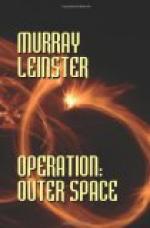“It feels like we’re solid. We won’t topple!”
Jones nodded. The rocket-sound cut off. Nothing happened.
“I think we could have saved fuel on that landing,” said Jones. Then he added, pleased, “Nice! The Dabney field’s still on! It has to be started in a vacuum, but it looks like it can hold air away from itself once it’s established. Nice!”
Babs rushed up the stairs. She gazed impassionedly out of a vision-port. Then she said disappointedly:
“It looks like—”
“It looks like hell,” said Cochrane. “Just smoke and steam and stuff. We can hope, though, that we haven’t started a forest fire, but have just burned off a landing-place.”
They stared out. Presently they went to another port and gazed out of that. The smoke was annoying, and yet it could have been foreseen. A moon-rocket, landing at its space-port on Earth, heated the tarmac to red-hotness in the process of landing. Tender-vehicles had to wait for it to cool before they could approach. Here the ship had landed in woodland. Naturally its flames had seared the spot where it came down. And there was inflammable stuff about, which caught fire. So the ship was in the situation of a phoenix, necessarily nesting in a conflagration. Anywhere it landed the same thing would apply, unless it tried landing on a glacier. But then it would settle down into a lake of boiling water, amid steam, and could expect to be frozen in as soon as its landing-place cooled.
Now there was nothing to do. They had to wait. Once the whole ship quivered very slightly, as if the ground trembled faintly under it. But there was nothing at which to be alarmed.
They could see that this particular forest was composed mainly of two kinds of trees which burned differently. One had a central trunk, and it burned with resinous flames and much black and gray-black smoke. The other was a curious growth—a solid, massive trunk which did not touch ground at all, but was held up by aerial roots which supported it aloft through very many slender shafts widely spread. Possibly the heavier part was formed on the ground and lifted as its air-roots grew.
It was irritating, though, to be unable to see from the ship so long as the fire burned outside. The pall of smoke lasted for a long time. In three hours there were no longer any fiercely blazing areas, but the ashes still smouldered and smoke still rose. In three hours and a half, the local sun began to set. There were colorings in the sky, beyond all comparison glorious. Which was logical enough. When Krakatoa, back on Earth, blew itself to bits in the eighteen hundreds, it sent such volumes of dust into the air that sunsets all around the globe were notably improved for three years afterward. On this planet, smoking cones were everywhere visible. Volcanic dust, then, made nightfall magnificent past description. There was not only gold and crimson in the west. The zenith itself glowed carmine and yellow, and those in the space-ship gazed up at a sky such as none of them could have imagined possible.




